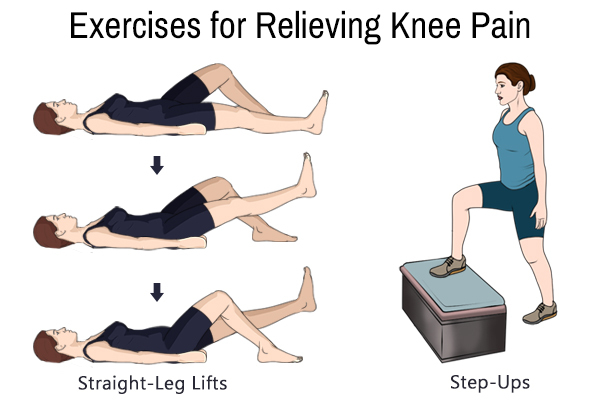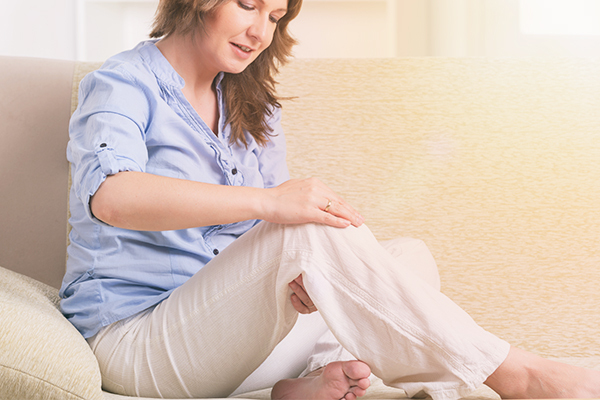In this article:
It is usual for adults to experience knee pain, which generally results from the wear and tear of daily activities, such as bending, walking, lifting, and standing.

Knee pain and its associated problems are also common among athletes who run or practice sports that require quick pivoting or jumping. Regardless of the reason, knee pain can cause discomfort, inconvenience, and even weakness in some cases.
Causes of Knee Pain
Knee pain can be a consequence of aging, continued stress on the knee joint, injury, or sudden knee movement. (1)(2) Common problems leading to knee pain include:
1. Osteoarthritis
It is one of the most frequent issues that affect the knee joint and is common in middle-aged and elderly individuals.
In this condition, the cartilage of the joint deteriorates and wears away with time. However, being overweight or having repetitive knee injury can also put you at a higher risk of osteoarthritis.
2. Rheumatoid arthritis
The damage to knee cartilage and the swelling associated with rheumatoid arthritis can contribute to knee pain. Rheumatoid arthritis is an inflammatory disease that usually affects people at younger ages in comparison with osteoarthritis.
3. Torn cartilage
A knee injury or trauma can cause tearing of the menisci, which are connective tissues that help absorb shock and improve stability. Sprains are a common reason for cartilage tears.
Usually, treatment involves the use of a brace during activities to prevent further damage. In some cases, surgical procedures may be required to repair the tear.
4. Muscular/ligamentous knee sprain and strain
Trauma or sudden twisting of the knee joint can cause sprain and strain, leading to knee pain and swelling.
5. Tendonitis
Inflammation in the tendons may result from their overuse during exercises such as running, cycling, or jumping. Patellar tendinitis, also known as jumper’s knees, is associated with strenuous sports that involve jumping.
Jumping generates a high amount of force on hitting the ground. This force can cause microtears and tendonitis.
6. Bursitis
Inflammation of the bursae, which are fluid-filled sacs around the joints, can also cause knee pain.
7. Other causes
Gout, infection, etc. are among the less common causes which can contribute to knee pain.
ALSO READ: What Causes Knee Pain and How to Treat It
Some Exercises to Reduce Knee Pain

Any exercise that strengthens the quadriceps muscle can be helpful. A few examples are:
- Straight-leg lifts: Lie down on your back and bend one of your legs. Keep the other leg straight, and lift it off the floor by tightening the thigh muscles. Hold for about 5 seconds and then try to lower the leg smoothly. Switch legs and repeat.
- Step-ups: For this exercise, use a 6-inch stair-step. Place one foot on the stair step and allow the other leg to hang loosely. Hold this position for 5 seconds and then repeat with the other leg.
- Single-leg dips: Place two chairs next to your hands. Hold the back of the chairs and slightly lift one leg in front of you. Bend the knee of the leg you are standing on and lower yourself a few inches. Hold this position for 5 seconds, straighten up, switch legs, and repeat.
Home Therapies for Knee Pain
Here are some things you can do at home to soothe your painful knees:
1. RICE treatment
For strains and sprains, rest, ice, compression, and elevation (RICE) of the injured limb are beneficial. Give rest to your knees. If this does not reduce your pain after a few days, consult your doctor or physical therapist for further examination and treatment. (3)
2. Soaking in warm water
If major causes of pain are already ruled out, soaking your knee in a warm tub will relieve the pain and will facilitate recovery, especially when combined with some hot tub exercises.
3. Oil massage
Any type of massage is good for relieving muscle tension and inflammation of the joints. (4) So, a slightly warm oil massage can help reduce the pain and is proven to provide supportive relief to patients with arthritis. (5)
Knee Pain May Worsen During the Night
Of patients with knee osteoarthritis, 60%–80% experience nighttime knee pain. (6) Knee pain at night is also common with conditions such as bursitis and tendinitis.
During the day when you do some physical activities, synovial fluid circulates the knee joint as you bend it. As a result, the swelling is not as much.
At rest, on the other hand, the muscles and tendons get a little bit tight. Therefore, the fluid does not have enough room and is not being actively pumped around. Swelling may increase, aggravating the symptoms.
Possible Reasons for Pain Behind the Knee
Baker’s cyst (popliteal cyst), which is the inflammation of the popliteal bursa, is a common reason for pain behind the knee. Arthritis, meniscal tears, and other referred pains are among other causes.
Precautionary Measures to Take When Suffering From Knee Pain
Avoid improper activities that put stress on the knee joints and pay enough attention to proper body mechanics when doing your daily activities.
Try to balance activity and rest, avoid overdoing activities, and do not forget to maintain a healthy weight. If you feel pain and swelling in your knees, take a break from running or any high-impact activity you are doing.
Most-Asked Questions About Knee Pain

Why are the elderly more prone to knee pain?
Old age is a major risk factor for osteoarthritis of the knee. While it has some genetic components, injury, infection, and being overweight are also associated with developing osteoarthritis. Additionally, women are at a high risk of developing the problem. (7)
Can one suffer from knee pain without any injury?
Sometimes, patients suffer from knee pain without a history of an obvious injury or trauma. Repeated injuries and inflammatory diseases are among the possible underlying pathologies in this case.
Does a clicking sound in the knee indicate any serious health problem?
Most of the time, it is either normal or due to a minor problem. But if you feel pain as the clicking occurs, it could be a sign of a meniscal tear, where there is a small piece of cartilage caught in the knee.
If you’re experiencing painful and persistent clicks, it could be due to osteoarthritis, in which the bones rub against each other, secondary to the wearing away of the smooth cartilage.
Another common condition resulting in the clicking of the knee is the unevenness of the inner surface of the patella, also known as the “runner’s knee.” You may feel the clicking more than you can hear it in this case.
What is the cause of sudden, sharp pain in the knees?
Sudden and sharp knee pain can result from a traumatic injury, a stress injury, or sometimes a flare-up from an underlying condition such as gout or infection.
It does not necessarily take a severe injury to cause a partial tear in the ligaments or to wear down the cartilage. Bursitis, rupture of a Baker’s cyst, and osteoarthritis can also trigger a sudden sharp pain.
How long does it generally take for knee pain to disappear?
Recovery time completely depends on the underlying condition. However, with proper care, most knee pains are expected to alleviate within 4 weeks approximately. However, more time is sometimes needed for complete healing.
What dietary changes should be made when suffering from knee pain?
Generally, a diet change is not needed but the following foods have been suggested to be helpful:
- Omega-3 fatty acids in fish oils
- Garlic and root vegetables
- Nuts and seeds
- Brassica vegetables
- Fresh fruits
- Lentils and beans
- Olive oil
- Whole grains
Final Word
Your knees carry your entire body weight and are therefore bound to suffer a lot of wear and tear over time. Moreover, the joint damage can be accentuated by other factors such as aging, excess body weight, injury, and other degenerative conditions.
Thus, knee pain can result from a wide range of causes, and its treatment will be determined accordingly. However, most common forms of knee pain can usually be managed at home through proper self-care, which often involves both rest and appropriate exercise. The pain should subside within a few days.
Consult a doctor if your condition persists, becomes progressively worse, or is accompanied by other worrying symptoms despite preliminary treatment.
- Was this article helpful?
- YES, THANKS!NOT REALLY


